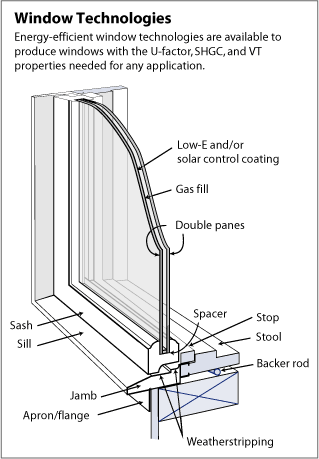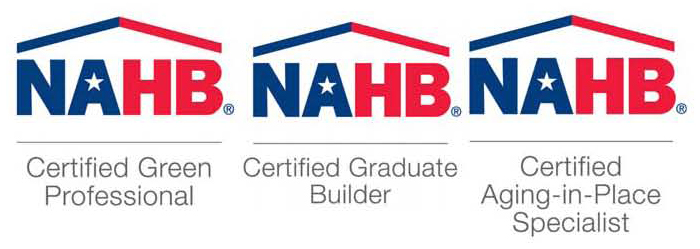Window Design & Selection
Window Design and installation
Before selecting new windows for your home, determine what types of windows will work best and where to improve your home's energy efficiency. It's a good idea to understand the energy performance ratings of windows so you’ll know what energy performance ratings you need for your windows based on your climate and the home's design.
For labeling energy-efficient windows, ENERGY STAR® has established minimum energy performance rating criteria by climate. However, these criteria don't account for a home's design, such as window orientation.
Windows are an important element in passive solar home design, which uses solar energy at the site to provide heating, cooling, and lighting for a house. Passive solar design strategies vary by building location and regional climate, but the basic window guidelines remain the same—select, orient, and size glass to maximize solar heat gain in winter and minimize it in summer.
In heating-dominated climates, major glazing areas should generally face south to collect solar heat during the winter when the sun is low in the sky. In the summer, when the sun is high overhead, overhangs or other shading devices prevent excessive heat gain.
To be effective, south-facing windows should have a solar heat gain coefficient (SHGC) of greater than 0.6 to maximize solar heat gain during the winter, a U-factor of 0.35 or less to reduce conductive heat transfer, and a high visible transmittance (VT) for good visible light transfer. See Energy Performance Ratings to learn more about these ratings.
Windows on east-, west-, and north-facing walls should be minimized while still allowing for adequate daylight. It is difficult to control heat and light through east- and west-facing windows when the sun is low in the sky, and these windows should have a low SHGC and/or be shaded. North-facing windows collect little solar heat, so they are used only for lighting. Low-emissivity (low-e) window glazing can help control solar heat gain and loss in heating climates.
In cooling climates, particularly effective strategies include preferential use of north-facing windows and generously shaded south-facing windows. Windows with low SHGCs are more effective at reducing cooling loads.
Some types of glazing help reduce solar heat gain, lowering a window's SHGC. Low-e coatings—microscopically thin, virtually invisible metal or metallic oxide layers deposited directly on the surface of glass—control heat transfer through windows with insulated glazing. Tinted glass absorbs a large fraction of incoming solar radiation through a window, reflective coatings reduce the transmission of solar radiation, and spectrally selective coatings filter out 40% to 70% of the heat normally transmitted through insulated window glass or glazing, while allowing the full amount of light to be transmitted. Except for spectrally selective, these types of glazing also lower a window's VT. See Window Types to learn more about glazing, coatings, tints, and other options when selecting efficient windows.
If you're constructing a new home or doing some major remodeling, you should also take advantage of the opportunity to incorporate your window design and selection as an integral part of your whole-house design—an approach for building an energy-efficient home.
Selection
You'll find that you have several options to consider when selecting what type of windows you should use in your home.
When selecting windows for energy efficiency, it's important to first consider their energy performance ratings in relation to your climate and your home's design. This will help narrow your selection.

A window's energy efficiency is dependent upon all of its components. Window frames conduct heat, contributing to a window's overall energy efficiency, particularly its U-factor. Glazing or glass technologies have become very sophisticated, and designers often specify different types of glazing or glass for different windows, based on orientation, climate, building design, etc.
Another important consideration is how the windows operate, because some operating types have lower air leakage rates than others, which will improve your home's energy efficiency. Traditional operating types include:
Awning.
Hinged at the top and open outward. Because the sash closes by pressing against the frame, they generally have lower air leakage rates than sliding windows.
Casement.
Hinged at the sides. Like awning windows, they generally have lower air leakage rates than sliding windows because the sash closes by pressing against the frame.
Fixed.
Fixed panes that don't open. When installed properly they're airtight, but are not suitable in places where window ventilation is desired.
Hopper.
Hinged at the bottom and open inward. Like both awning and casement, they generally have lower air leakage rates because the sash closes by pressing against the frame.
Single- and double-hung.
Both sashes slide vertically in a double-hung window. Only the bottom sash slides upward in a single-hung window. These sliding windows generally have higher air leakage rates than projecting or hinged windows.
Single- and double-sliding.
Both sashes slide horizontally in a double-sliding window. Only one sash slides in a single-sliding window. Like single- and double-hung windows, they generally have higher air leakage rates than projecting or hinged windows.
Installation
Even the most energy-efficient window must be properly installed to ensure energy efficiency. Therefore, it's best to have a professional install your windows.
Window installation varies depending on the type of window, the construction of the house (wood, masonry, etc.), the exterior cladding (wood siding, stucco, brick, etc.), and the type (if any) of weather-restrictive barrier.
Windows should be installed according to the manufacturer’s recommendations and be properly air sealed during installation to perform correctly. To air seal the window, caulk the frame and weatherstrip the operable components.
You can use the energy performance ratings of windows, doors, and skylights to tell you their potential for gaining and losing heat, as well as transmitting sunlight into your home.
Window Energy Performance Testing, Certification, and Labeling
The National Fenestration Rating Council (NFRC) operates a voluntary program that tests, certifies, and labels windows, doors, and skylights based on their energy performance ratings. The NFRC label provides a reliable way to determine a window's energy properties and to compare products.
The NFRC label can be found on all ENERGY STAR® qualified window, door, and skylight products, but ENERGY STAR bases its qualification only on U-factor and solar heat gain coefficient ratings, which are described below.
Heat Gain and Loss
Windows, doors, skylights can gain and lose heat through:
Direct conduction through the glass or glazing, frame, and/or door
The radiation of heat into a house (typically from the sun) and out of a house from room-
temperature objects, such as people, furniture, and interior walls
Air leakage through and around them.
These properties can be measured and rated according to the following energy performance characteristics:
U-factor
is the rate at which a window, door, or skylight conducts non-solar heat flow. It's usually expressed in units of Btu/hr-ft2-oF. For windows, skylights, and glass doors, a U-factor may refer to just the glass or glazing alone. NFRC U-factor ratings, however, represent the entire window performance, including frame and spacer material. The lower the U-factor, the more energy-efficient the window, door, or skylight.
Solar heat gain coefficient (SHGC)?
is the fraction of solar radiation admitted through a window, door, or skylight -- either transmitted directly and/or absorbed, and subsequently released as heat inside a home. The lower the SHGC, the less solar heat it transmits and the greater its shading ability. A product with a high SHGC rating is more effective at collecting solar heat during the winter. A product with a low SHGC rating is more effective at reducing cooling loads during the summer by blocking heat gain from the sun. Your home’s climate, orientation, and external shading will determine the optimal SHGC for a particular window, door, or skylight. For more information about SHGC and windows, see passive solar window design.
Air leakage?
is the rate of air movement around a window, door, or skylight in the presence of a specific pressure difference across it. It's expressed in units of cubic feet per minute per square foot of frame area (cfm/ft2). A product with a low air leakage rating is tighter than one with a high air leakage rating.
Sunlight Transmittance
The ability of glazing in a window, door, or skylight to transmit sunlight into a home can be measured and rated according to the following energy performance characteristics:
Visible transmittance (VT) is a fraction of the visible spectrum of sunlight (380 to 720 nanometers), weighted by the sensitivity of the human eye, that is transmitted through the glazing of a window, door, or skylight. A product with a higher VT transmits more visible light. VT is expressed as a number between 0 and 1. The VT you need for a window, door, or skylight should be determined by your home's daylighting requirements and/or whether you need to reduce interior glare in a space.
Light-to-solar gain (LSG)
is the ratio between the SHGC and VT. It provides a gauge of the relative efficiency of different glass or glazing types in transmitting daylight while blocking heat gains. The higher the number, the more light transmitted without adding excessive amounts of heat. This energy performance rating isn't always provided.
Skip Howes
CGP - Certified Green Professional
CGB - Certified Graduate Builder
CAPS - Certified Aging in Place Specialist
RRP - Certified Lead Paint Renovator
Scott Homes, Ltd., Designers & Builders
President


Schedule An Inspection
By Phone or Email we can schedule the services you desire to begin saving money on your utility bills!
Contact Us Online
Email us at info@ColoradoEnergyAnalysts.com
© Copyright 2013-2024 - Colorado Buys Local Inc | Designed for Colorado Energy Analysts
